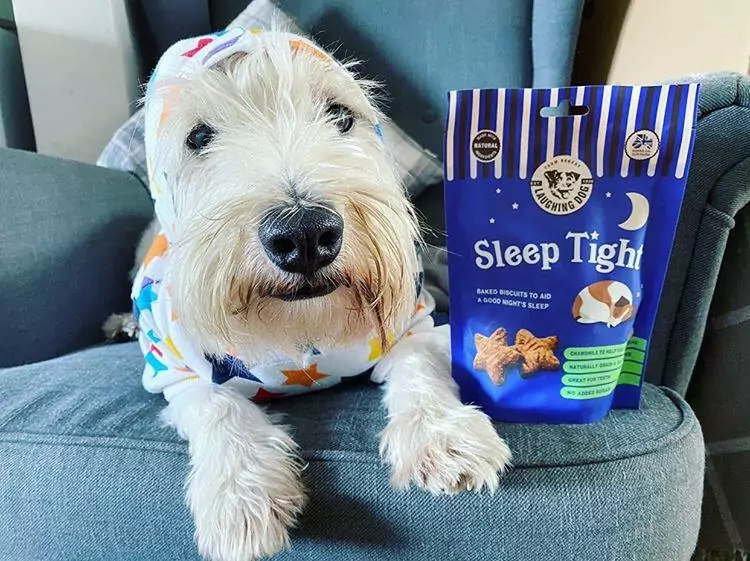
Why is my dog hyperactive at bedtime?
There are many reasons why your dog may struggle to settle down at night sometimes it is merely down to the breed or age of your dog which makes the evenings a hyperactive experience. Other reasons might include dog anxiety or stress, much like us humans, dogs can suffer from stress and anxiety which can stop them from falling asleep.
If you see that your dog struggling to get comfortable; constant panting or going round in circles this might be a sign that they are dealing with anxiety. Read our blog on anxiety for information on how to deal with this behaviour. Another reason for your dogs’ nighttime hyperactive behaviour could be that they have not had enough physical activity during the day.
Much like a human if we do not burn off excess energy during the daytime we can sometimes struggle to sleep at night, you will often find on days where you’ve been busy or very active that you know you’re going to be in for a good nights sleep. Well, it’s very much the same situation for your four-legged friend. Check out our recent blog on the ultimate guide to walking your dog!
Another reason might be because you are feeding your dog too late into the day, again the same as us humans we do need time to digest our food before going to bed. Always try to feed your dog at least 3 hours before bedtime this will mean that they have time to digest, relieve themselves and settle down for a restful night.
Once you have established the root cause of your dog’s hyperactive behaviour, you might be able to counteract it very easily. If not, try the following steps to create a soothing and relaxing environment for your dog to settle down in.
Doggy massage for hyperactive dogs
If you’re trying to calm hyperactive dogs before bedtime, a relaxing massage can work wonders in creating a calming state. This one-to-one bonding time with your dog can be a natural way of calming down hyperactive behaviour.
Start the massage by gently petting your dog all over, while you begin your massage always gently talk to your dog to keep them calm and relaxed. Massage on your dog’s neck by making circular movements but keep the pressure gentle so that it’s relaxing and not too painful. Massage down to your dog’s shoulders, this is an area of the body that dogs cannot reach themselves so they sometimes have little itches, aches or pains here which they cannot reach themselves.
Spend quite a bit of time in this area. From the shoulders, you can move on to the chest and front legs. Some canines are averse to having their legs touched, if this is the case, try different parts of the body.
However long, slow and gentle strokes up and down their legs is a very relaxing sensation for a dog, so if they are comfortable with having their legs massaged this can put them into a very restful state. Always make sure that the movements are long and gentle ideally keeping away from the face so that they do not feel like they are being fussed and avoid getting excitable.
Relaxing sounds and smells
Much like humans who often spray their pillows with essential oils, these calming scents can also be a way to soothe an overactive dog. However, you do need to be careful with which essential oils you use to help create a relaxing environment.
Some essential oils are toxic to pets, whether they sniff them, lick them or get them on their coat, they can cause adverse effects.
Look out for the safe essential oils:
Bergamot
Lavender
Sweet Marjoram
Rose Damask
Chamomile
Those listed above are our favourites and should not cause any significant effects or damage to your dog. Couple essential oils with relaxing music to create the ultimate stress-free environment to settle your hyperactive dogs.
Researchers have shown that playing classical music to a dog can create a state of calm. A notable study looked at the effects of relaxing music for dogs and in stressful environments, particularly in shelters, found that classical music triggers a more restful environment.
Although scientists have not completely proven why this is the case, psychology suggests that relaxing sounds can help reduce a dog’s heart rate and therefore put them into a more calmed nature. Check out Spotify or YouTube for endless lists of dogs’ suitable music and calming background sounds.
Relaxing bedtime treats
It is possible to help hyperactive dogs before bedtime by feeding them the right treats, although it may sound wrong and against the rule of three hours prior to bed, just a couple of treats can be enough to help hyperactive dogs relax.
Laughing Dogs Sleep Tight Night-Time Treats are perfect for this, as they contain chamomile which is often regarded as a mild tranquilliser or sleep inducer. Its calming effect may be attributed to an antioxidant called apigenin which works the same for both humans and dogs alike.
Regular routine
Make sure that your dog has a regular and calm routine every night. This is sure to help break hyperactive behaviour. Always wind down for your evenings at the same time allowing your dog to finish his meal, have a toilet break and end playtime at a reasonable time.
During this bedtime routine, try not to react to your dog’s demands, quite often hyperactive dogs are still demanding into the evening by bringing you toys and demanding your attention. Try to ignore these demands and take away their toys at least a couple of hours before bedtime.
If you combine this routine with relaxing bedtime treats, aromatherapy, calming music and a gentle massage your hyperactive dogs days will be no more. Follow our YouTube channel for more.



